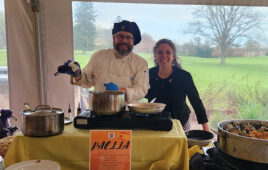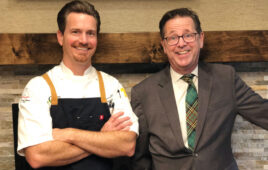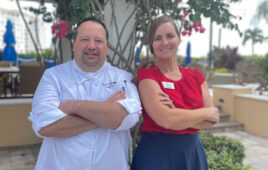Gerald Ford, CMC, offers suggestions for club and resort chefs as they develop new food-safety systems and strengthen existing ones, in the wake of COVID-19.

At Onwentsia Club (Lake Forest, Ill.), Executive Chef James Bondoc and his culinary team are focused on washing hands, wearing masks and gloves, logging staff temperatures, and limiting those working in the kitchen.
Chefs provide nourishment. Everything we produce for consumption enters the human body and is not subject to the rules of social distancing. As leaders, we must take the necessary actions to help tip the scale and reduce the spread of the coronavirus.
For those who have not already developed a working relationship with it, HACCP—or the Hazard Analysis Critical Control Point system—is a process that identifies where hazards might occur in the food production process and creates standardized systems to monitor and mitigate potential threats to health and safety.
It’s more relevant now than ever before. And it’s critical that chefs leverage HACCP to create standard operating procedures for all parts of their operations.
The key to any HACCP program is doing it—and doing starts with understanding.
In this case, the spread of COVID-19 is our “hazard.” When you analyze your operations, look for the gaps. Food handlers are a “critical control point” and they represent an opportunity to control the hazard.
Here are some suggestions to ensure that everything possible is being done to protect employees, members, and others from this new hazard.
First, chefs must ensure that cooks are not carrying the virus. Consider adding a screening process using temperature-scanning equipment. If an employee registers a temperature over 99°F, he or she must be sent home.
Have employees change into uniforms upon arrival, to remove any additional risk. Uniforms must be clean and aprons washed often. Surfaces must be sanitized frequently.
Use facemasks and gloves, and make sure everyone maintains a six-foot distance from each other—use tape on the floor as a visual cue to keep your team well-spaced. Stagger start times, so employees aren’t arriving at the same time.
Refresh employees on proper sanitation practices and food safety. Include Food Safety Test. Remind them about fundamentals, like not touching faces and proper hand washing.
Beyond the human factor, it is important that chefs consider adding a level of scrutiny to your to-go, carryout and delivery practices. Your members trust you. Use that trust to further protect them. Modify your packaging, so that containers have tamper-evident stickers or seals that link openings.
It’s also worthwhile for chefs to take this time to reevaluate the products you use to clean and sanitize your operations.
Your members’ lives are in your hands. Follow the flow of the food in your operation. This is where prevention starts. Now is the time for vigilance in every facet. As the leader, you set the standard.




